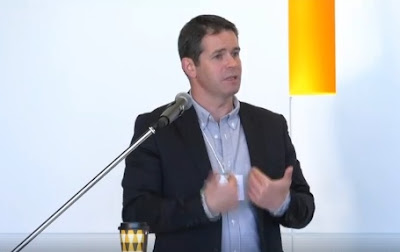 |
| Bruce Fields delivering the 1st paper of the Symposium |
The paper response was given by George Kalantzis, Professor of Theology at Wheaton College and Director of the Wheaton Center of Early Christian Studies, whose main criticism was the use of Augustine in support of Field's (evangelical) reading of Paul's letters when Augustine, in the opinion of Kalantzis, should simply be read for his own sake.
The next morning (Sept. 29), the 2nd session featured a paper read by Grant Macaskill, The Kirby Laing Chair of New Testament Exegesis at the University of Aberdeen, and entitled: "Union(s) with Christ: Colossians 1:15-20." Macaskill picked up where he left off in his Lund Lectures and further interpreted Col 1:15-20.
 |
| Grant Macaskill giving the second paper of the Symposium |
It should be noted that Macaskill is careful, however, not to talk about unions as if it was a kind of flat universalism (a critique of Douglas Campbell's work in The Deliverance of God). Macaskill is not a universalist and does posit the unique union of believers with Chrsit but also recognizes it as a fullfillment of all previous types of unions established in the history of God with His people. The link to the video of the 2nd session of the Symposium is below:
The paper response was given by Constantine Campbell, Professor of New Testament at Trinity Evangelical Divinity School, who has also written his own separate monograph on Paul and Union with Christ.
It was a lively response and engagement with Macaskill's paper. Con (not be confused with Doug) Campbell engaged Macaskill's reading of Col 1:15-20 from the minute details of whether the genitive's attached to the word "first-born" were partitive (Macaskill's view, which makes the phrase a temporal reading, i.e., "first-born of all creation") or subordinate (Campbell's view, which would then read "first-born over all creation") to addressing larger historical issues as: which covenant (Abraham, Mosaic, David, creational) does Paul refers to at specific points in the biblical text.
The following 3rd session featured a paper by Olli-Pekka Vainio, Lecturer of Systematic Theology at the University of Helsinki, entitled: “Why Bother with Participation? An Early Lutheran Perspective." Vainio has written a "few" books and articles (195+), the most important of which for the symposium's theme include: Justification and Participation in Christ and Engaging Luther. Vainio represents the new Finnish school of interpretation on the theology of Martin Luther. Vainio paper's focuses on a second-generation Lutheran reformer named Martin Chemnitz (1522-86) who expanded on Luther's teachings and used the hypostatic union of the two natures of Christ as a way of framing the separate divine and human agencies of participation.
 |
| Olli-Pekka Vainio giving the 3rd paper of the Symposium |
The link to the video of the 3rd session of the Symposium is below:
The 4th session that afternoon was from Julie Canlis, Lecturer at Regent College and author of the book Theology of the Ordinary, who read a paper entitled: "The Geography of Participation: In Christ Is Location, Location, Location."
 |
| Julie Canlis giving the 4th paper of the Symposium |
If all of this sounds a little abstract, Julie and her husband, a pastor, have put together an adult curriculum with accompanying video that offers Bible study, commentary, and best spiritual practices for participation in the life of God through the daily details of the ordinary.
The paper response was given by Mary Patton Baker, Lecturer at North Park University and Pastor of Community Formation at All Soul's Anglican Church. The link to the video of the 4th session of the Symposium can be found below:
Coming soon: Part 2 of the 2017 Symposium on Participation in/Union with Christ with links to video and remarks on Sessions 5-8. MJL
